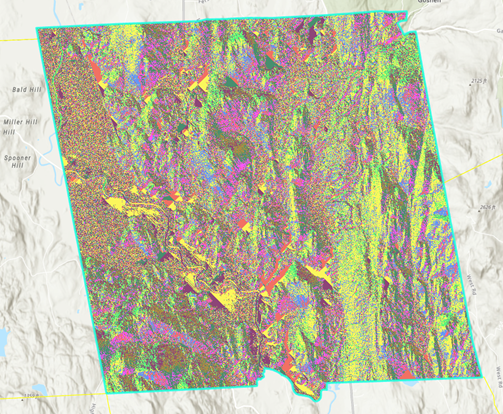

The Multiple Flow Direction (MFD) algorithm, described by Qin et al. When calculating the drop raster in flat areas, the distance to diagonally adjacent cells ( 1.41421 * cell size) is approximated by 1.4 * cell size for improved performance. The result is a map of percent rise in the path of steepest descent from each cell. Across a flat area, the distance becomes the distance to the nearest cell of lower elevation. For adjacent cells, this is analogous to the percent slope between cells. The output drop raster is calculated as the difference in z-value divided by the path length between the cell centers, expressed in percentages.

If a cell has the same change in z-value in multiple directions and is not part of a sink, the flow direction is assigned with a lookup table defining the most likely direction. By using the Spatial Analyst Sink tool can be used to flag Cells with undefined flow direction as sinks, For example, if the change in z-value is the same both to the right (flow direction = 1) and down (flow direction = 4), the flow direction for that cell is 1 + 4 = 5. In such cases, the value for that cell in the output flow direction raster will be the sum of those directions. If a cell has the same change in z-value in multiple directions and that cell is part of a sink, the flow direction is referred to as undefined. This is used to filter out one-cell sinks, which are considered noise. If multiple neighbors have the lowest value, the cell is still given this value, but flow is defined with one of the two methods explained below. If a cell is lower than its eight neighbors, that cell is given the value of its lowest neighbor, and flow is defined toward this cell. The values for each direction from the center are the following:įor example, if the direction of steepest drop was to the left of the current processing cell, its flow direction would be coded as 16. The output of the Flow Direction tool run with the D8 flow direction type is an integer raster whose values range from 1 to 255.

The D8 flow method models flow direction from each cell to its steepest downslope neighbor. Those are D8, Multi Flow Direction (MFD) and D-Infinity (DINF). The Flow Direction tool supports three flow modeling algorithms. This tool does not support local raster data or layers.

The input raster layer supports a layer from the portal, a URI or URL to an image service, or the output from the Make Image Server Layer tool. The portal tool accepts layers from your portal as input and creates output in your portal. When the tool is invoked, ArcGIS Pro serves as a client and the processing occurs in the servers federated with ArcGIS Enterprise. This raster analysis portal tool is available when you are signed in to an ArcGIS Enterprise portal that has an ArcGIS Image Server configured for Raster Analysis.


 0 kommentar(er)
0 kommentar(er)
